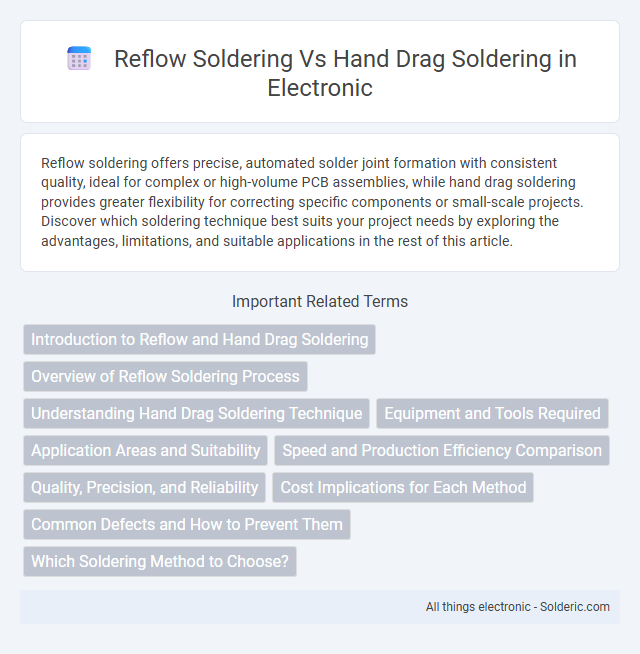Reflow soldering offers precise, automated solder joint formation with consistent quality, ideal for complex or high-volume PCB assemblies, while hand drag soldering provides greater flexibility for correcting specific components or small-scale projects. Discover which soldering technique best suits your project needs by exploring the advantages, limitations, and suitable applications in the rest of this article.
Comparison Table
| Aspect | Reflow Soldering | Hand Drag Soldering |
|---|---|---|
| Process Type | Automated, uses solder paste and controlled heating | Manual, involves dragging solder with a soldering iron |
| Precision | High consistency and precision for small components | Depends on operator skill, less consistent |
| Production Volume | Ideal for high-volume manufacturing | Suitable for low-volume or prototyping |
| Cost | Higher initial equipment cost, lower labor cost | Lower equipment cost, higher labor cost |
| Speed | Fast and uniform soldering cycle | Slower, time-consuming for complex boards |
| Application | Surface Mount Technology (SMT) assemblies | Through-hole and some SMT repairs or touch-ups |
| Heat Control | Precise thermal profiles to avoid component damage | Operator controlled, less precise heat application |
Introduction to Reflow and Hand Drag Soldering
Reflow soldering uses precise temperature-controlled ovens to melt solder paste, enabling consistent and automated attachment of surface-mount components on printed circuit boards (PCBs). Hand drag soldering involves manually moving solder and flux with a soldering iron tip along component leads to create reliable joints, often employed for touch-ups or small-scale repairs. Understanding these methods helps you choose between efficient mass production and detailed manual soldering tasks.
Overview of Reflow Soldering Process
Reflow soldering involves applying solder paste to PCB pads and then heating the assembly in a controlled oven to melt the solder, creating secure joints between components and the board. This automated process ensures precise temperature profiles and uniform soldering, reducing human error and improving consistency in high-volume production. Your choice of reflow soldering can significantly enhance manufacturing efficiency, especially for complex surface-mount technology (SMT) assemblies.
Understanding Hand Drag Soldering Technique
Hand drag soldering involves using a heated soldering iron to smoothly drag solder across PCB pads and component leads, creating precise joints without excessive heat exposure. This technique requires skill in temperature control and steady hand movement to avoid bridging or cold joints, making it ideal for fine-pitch components. In contrast to reflow soldering, which melts solder paste uniformly through oven heat, hand drag soldering offers more immediate control over individual connections during assembly or repair processes.
Equipment and Tools Required
Reflow soldering requires a reflow oven or infrared heater along with solder paste stencils and screen printers to apply precise solder paste deposits, ensuring consistent and automated soldering of surface-mount components. Hand drag soldering relies on manual tools, such as a soldering iron with a fine tip, solder wire, and flux, allowing for targeted application but requiring greater skill and time. Your choice between these methods impacts equipment investment, production volume, and soldering precision.
Application Areas and Suitability
Reflow soldering is ideal for mass production of complex printed circuit boards (PCBs) with surface-mount devices (SMDs) due to its precision and uniform heat application, commonly used in consumer electronics and automotive industries. Hand drag soldering suits small-scale or repair work on through-hole components or prototypes, offering flexibility and control for intricate manual assembly tasks. Choosing between the two depends on production volume, component type, and required solder joint consistency.
Speed and Production Efficiency Comparison
Reflow soldering offers significantly higher speed and production efficiency compared to hand drag soldering, enabling rapid assembly of complex circuit boards with consistent quality. Your manufacturing process benefits from automated precision and scalability, reducing labor costs and minimizing human error. Hand drag soldering, while flexible for small batches or repairs, cannot match the throughput or uniformity delivered by reflow soldering in mass production environments.
Quality, Precision, and Reliability
Reflow soldering delivers superior quality and precision by automating the soldering process, ensuring consistent joint formation and minimizing human error. Hand drag soldering offers flexibility for small-scale or complex repairs but often sacrifices reliability due to operator variability and lower repeatability. For high-volume manufacturing, reflow soldering provides greater consistency and long-term reliability compared to manual drag soldering techniques.
Cost Implications for Each Method
Reflow soldering involves higher initial investment due to the cost of specialized equipment and setup but offers lower per-unit costs through automation and increased throughput, making it cost-effective for large-volume production. Hand drag soldering requires minimal upfront expense and is suitable for small batches or prototypes but incurs higher labor costs and longer process times, reducing overall cost efficiency for mass production. Evaluating cost implications involves considering production scale, with reflow soldering optimized for bulk manufacturing and hand drag soldering favored for low-volume or repair tasks.
Common Defects and How to Prevent Them
Reflow soldering commonly faces defects like solder bridging, tombstoning, and insufficient wetting caused by improper temperature profiles or poor stencil design, which You can prevent by carefully optimizing the reflow oven parameters and ensuring precise solder paste application. Hand drag soldering often results in defects such as solder balls, cold joints, and pad damage, typically due to inconsistent solder application or inadequate heat control, mitigated by skilled operator training and using the correct soldering iron temperature. Consistent inspection and process control are essential in both methods to minimize defects and improve solder joint reliability.
Which Soldering Method to Choose?
Reflow soldering offers precise, consistent joints ideal for high-volume, complex PCB assemblies, ensuring reliability and efficiency in your production process. Hand drag soldering provides greater control and flexibility for prototyping or small batch repairs, allowing you to address delicate components individually. Choosing the right method depends on your project scale, component sensitivity, and production speed requirements to optimize quality and cost-effectiveness.
Reflow soldering vs hand drag soldering Infographic

 solderic.com
solderic.com